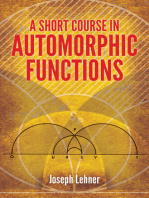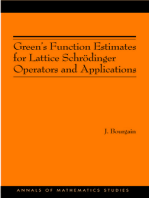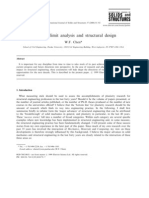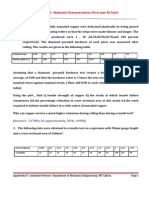En0175 07 PDF
En0175 07 PDF
Uploaded by
Thangadurai Senthil Ram PrabhuCopyright:
Available Formats
En0175 07 PDF
En0175 07 PDF
Uploaded by
Thangadurai Senthil Ram PrabhuOriginal Description:
Original Title
Copyright
Available Formats
Share this document
Did you find this document useful?
Is this content inappropriate?
Copyright:
Available Formats
En0175 07 PDF
En0175 07 PDF
Uploaded by
Thangadurai Senthil Ram PrabhuCopyright:
Available Formats
EN0175
09 / 26 / 06
Review on coordinate transformation (change of basis) for tensors.
v e3
v' e2
v e1
v v v' u = ui ei = u 'p e p v v' v v' = ui ei e p u 'p = u e p v v ' v' v ui = u ei = uq eq ei
v v' u e
1
v e2
v' e3
)
' v v' v v' ' u 'p = uq ei eq ei e p = u q Qiq Qip
Combining the above 2 equations yields Therefore Similarly, we can show
)(
Qiq Qip pq Qip Q jp ij
(Hint: using ui = u j e j e p ei e p = u j Qip Q jp )
(v
v' v v'
)(
In matrix form:
QQ = I , Q Q= I
T T
Such matrices/tensors are called orthogonal matrices/tensors. Example: Transformation from 2D Cartesian coordinate to 2D Polar coordinate.
v e2
r
v e
v er
v e1
1
EN0175
09 / 26 / 06
cos Q= sin
sin cos T , QQ = cos sin
sin cos cos sin
sin 1 0 = cos 0 1
Chap 3. Stress in a solid Continuum Continuous media ignoring the atomic and other discreteness of matters. Density
( V is smaller than all important dimensions but still contains sufficient number of atoms)
M V
(V 0) .
v v P n
v F
Homogeneity All points have the same material properties. (Opposite term: Heterogeneity) Isotropy Material properties are the same in different directions. (Opposite term: Anisotropy) Forces in a continuum: External (applied) forces Body (volume) forces
v F total body force on V (e.g. gravity).
v v F f = lim V 0 V
For example: The body force due to gravity can be written as
EN0175
09 / 26 / 06
3
2
g
1
v v f = g e3
Surface forces
v P total surface forces on S .
v v P t = lim S 0 S
For example: A uniform pressure on top of a block can be written as
3
2
1
v v t = p e3
Internal forces
v v ( n t )
v v (n ) t v n v n
vv t (n ) : traction vector at a point.
EN0175
09 / 26 / 06
According to Newtons action-reaction law,
vv v v t ( n ) = t ( n )
Simple example for 1D:
Let us put these concepts in terms of base vectors:
v v v v v v vv v (e v (e v (e ) ) ) t (e1 ) = t1 1 e1 + t2 1 e2 + t3 1 e3 v v v v v v vv v (e v (e v (e ) ) ) t (e2 ) = t1 2 e1 + t2 2 e2 + t3 2 e3 v v v v v v vv v (e v (e v (e ) ) ) t (e3 ) = t1 3 e1 + t2 3 e2 + t3 3 e3
We can define
ij = t j (e ) ,
i
which is the so-called Cauchy stress. The subscript i denotes the direction of plane normal and j denotes the direction of force.
33
32 31 13
11 12
23
21
22
1
Traction on an arbitrary plane with normal vector n
EN0175
09 / 26 / 06
S 2
v n
S1
v v ( e t 2)
v n
v v ( e t 1) v v (n t )
2
S3
1
S
1
v v t ( e3 )
Consider force equilibrium on the tetrahedron shown above:
v vv v v v v v v t (n ) S + t ( e1 ) S1 + t ( e2 ) S 2 + t ( e3 ) S 3 + f V = 0 ,
where f is the body force (which can also include inertia forces). Let S 0 ,
v V v v v v S v v S v v S t (n ) + t (e1 ) 1 + t (e2 ) 2 + t (e3 ) 3 + f =0 S S S S
1 V ~ S 2 0 as S 0 (This is the same as saying that the surface-to-volume ratio S
becomes very large as the volume shrinks to zero.) Consider the volume of the tetrahedron, V =
1 1 S h = S1 h1 3 3
S1 h v = = cos 1 = n e1 = n1 S h1
3
S1
h1
2
h1
S
1
5
EN0175
09 / 26 / 06
Similarly,
S 2 S3 = n2 , = n3 S S
where n1 , n2 , n3 are the components of the normal vector n ( n = n1e1 + n2 e2 + n3e3 ). Hence,
vv vv vv vv t (n ) = t (e1 )n1 + t (e2 )n2 + t (e3 )n3
In index notation,
v v v (n ) v (e ) t j = t j i ni = ij ni
i.e.
vv T v t (n ) = n
Special cases:
vv v v v v v t (e1 ) = e1 = ij (ei e j )ei = 1 j e j vv v t ( e2 ) = L = 2 j e j vv v t (e3 ) = L = 3 j e j
11 , 22 , 33 are called the normal stresses (on a base plane). 12 , 13 , 23 etc. are called the shear stresses (on a base plane).
You might also like
- Weak & Strong FormDocument23 pagesWeak & Strong FormZainuri NorliyatiNo ratings yet
- En0175 08 PDFDocument6 pagesEn0175 08 PDFThangadurai Senthil Ram PrabhuNo ratings yet
- δ F δm g, where: Forces acting on a differential element of fluidDocument8 pagesδ F δm g, where: Forces acting on a differential element of fluidsuwashacharyaNo ratings yet
- En0175 05 PDFDocument6 pagesEn0175 05 PDFThangadurai Senthil Ram PrabhuNo ratings yet
- On Saint Venant's PrincipleDocument8 pagesOn Saint Venant's PrincipleRegina MillerNo ratings yet
- Appendix A-Historic Intro of CalculusDocument8 pagesAppendix A-Historic Intro of CalculusPiyush DaveNo ratings yet
- Navier Stokes EquationsDocument5 pagesNavier Stokes EquationszaraakinaeNo ratings yet
- Mathematical Description of Conservation Equations Involving An InterfaceDocument16 pagesMathematical Description of Conservation Equations Involving An InterfaceeustaccoNo ratings yet
- E e e e e E: We Continue On The Mathematical Background. Base Tensors: (Dyadic Form)Document6 pagesE e e e e E: We Continue On The Mathematical Background. Base Tensors: (Dyadic Form)Thangadurai Senthil Ram PrabhuNo ratings yet
- Mechanic of Solids: Stress and StrainDocument28 pagesMechanic of Solids: Stress and StrainLuis VarelaNo ratings yet
- FEM FullDocument423 pagesFEM FullHarish LambadiNo ratings yet
- 03 TensorsDocument12 pages03 TensorsHamed MemarianNo ratings yet
- 17.lecture 27 Finite Element Derivation PDFDocument17 pages17.lecture 27 Finite Element Derivation PDFKarina NaudéNo ratings yet
- Fluid Flow in Solidification 2Document8 pagesFluid Flow in Solidification 2Anonymous T02GVGzBNo ratings yet
- Governing Equations For Fluid Motion: K W J V I U VDocument16 pagesGoverning Equations For Fluid Motion: K W J V I U VKelvin SudaniNo ratings yet
- A Shortcoming in The Geometrically Non-Linear Shakedown TheoremDocument2 pagesA Shortcoming in The Geometrically Non-Linear Shakedown TheoremRui CbNo ratings yet
- Introduction of Solid Mechanics (ME 621) : Problem 1Document4 pagesIntroduction of Solid Mechanics (ME 621) : Problem 1Ritunjay JhaNo ratings yet
- Aerodynamics A Full VersionDocument24 pagesAerodynamics A Full VersionVaishnavi SundarNo ratings yet
- Summary of The Plate Equations: D W P X, yDocument4 pagesSummary of The Plate Equations: D W P X, yAndrés MercadoNo ratings yet
- Chapter 2 Mechanics of Materials: Normal StressDocument18 pagesChapter 2 Mechanics of Materials: Normal StressPalak AriwalaNo ratings yet
- Fluid Rotation: Figure. Rectangular Fluid Particle With Two Instantaneous PerpendicularDocument10 pagesFluid Rotation: Figure. Rectangular Fluid Particle With Two Instantaneous PerpendicularEmreNo ratings yet
- Gaya - Gaya Fiskositas (Viscous Forces)Document13 pagesGaya - Gaya Fiskositas (Viscous Forces)Aditya Eka PurnamaNo ratings yet
- Kittel Kroemer Thermal PhysicsDocument40 pagesKittel Kroemer Thermal PhysicscarlnigNo ratings yet
- Chapter 1Document176 pagesChapter 1Shaina Mariz PanaliganNo ratings yet
- Continuum Mechanics - TensorsDocument12 pagesContinuum Mechanics - TensorsBrian WoodNo ratings yet
- Stresses in LiquidsDocument9 pagesStresses in LiquidsAl-Kawthari As-SunniNo ratings yet
- Chapter 8 Navier-Stokes EquationDocument16 pagesChapter 8 Navier-Stokes EquationSyahiran SalehNo ratings yet
- HW 1 SolutionDocument9 pagesHW 1 SolutionbharathNo ratings yet
- Derivation of The Navier-Stokes Equations, and Implications For Groundwater FlowDocument20 pagesDerivation of The Navier-Stokes Equations, and Implications For Groundwater FlowsuryaNo ratings yet
- ST Venant's PrincipleDocument8 pagesST Venant's PrincipleJovit JosephNo ratings yet
- Lecture Notes, M261-004, Torsion and The Unit Binormal VectorDocument3 pagesLecture Notes, M261-004, Torsion and The Unit Binormal VectorRifqi AndiNo ratings yet
- Cartan EquationDocument9 pagesCartan EquationenlightenedepNo ratings yet
- 1 The Navier-Stokes EquationsDocument14 pages1 The Navier-Stokes EquationsMeer Mustafa AliNo ratings yet
- Euler Equations in Fluid DynamicsDocument11 pagesEuler Equations in Fluid Dynamicsshyamal_ranjan4474No ratings yet
- Physics430 Lecture04Document22 pagesPhysics430 Lecture04Azwar SutionoNo ratings yet
- Lecture No4 Application Linear Momentum Principle PDFDocument9 pagesLecture No4 Application Linear Momentum Principle PDFshNo ratings yet
- Full Elementary Aerodynamics Course by MITDocument158 pagesFull Elementary Aerodynamics Course by MIT34plt34No ratings yet
- Navier Stokes EquationDocument26 pagesNavier Stokes EquationHina MeoNo ratings yet
- Freefall With Air ResistanceDocument8 pagesFreefall With Air ResistanceSab95No ratings yet
- MethodsI IIDocument9 pagesMethodsI IIMahmood PashiNo ratings yet
- Differential Continuity Equation: Eynolds Ransport HeoremDocument5 pagesDifferential Continuity Equation: Eynolds Ransport Heoremquaid_vohraNo ratings yet
- 1 3 Dimensional Stress TransformationDocument12 pages1 3 Dimensional Stress TransformationAisha AbuzgaiaNo ratings yet
- Jackson Electrodynamics, Notes 1Document5 pagesJackson Electrodynamics, Notes 1Tianyi ZhangNo ratings yet
- 1.4 What Is Cfd?: M M ⟹ Ρva Dm Dt ∑F ⟹ F=Ma, M=Mv, Dm Dt D (Mv) DtDocument43 pages1.4 What Is Cfd?: M M ⟹ Ρva Dm Dt ∑F ⟹ F=Ma, M=Mv, Dm Dt D (Mv) DtTeh Boon SiangNo ratings yet
- Cubical DilationDocument5 pagesCubical DilationChintu Kishen KMNo ratings yet
- A9 PDFDocument2 pagesA9 PDFdoraNo ratings yet
- What Is A Wave? Forward vs. Backward Propagating Waves The One-Dimensional Wave EquationDocument22 pagesWhat Is A Wave? Forward vs. Backward Propagating Waves The One-Dimensional Wave EquationEster DanielNo ratings yet
- ConsolidationDocument80 pagesConsolidationAdrian Mufc RampersadNo ratings yet
- 6.7 Introduction Dynamics in Three Dimensions A. General PrinciplesDocument12 pages6.7 Introduction Dynamics in Three Dimensions A. General PrincipleselvyNo ratings yet
- IIIA2 FluidFlowConceptsContinuedDocument63 pagesIIIA2 FluidFlowConceptsContinuedKenneth KnowlesNo ratings yet
- Graetz ProblemDocument13 pagesGraetz ProblemBelialVKWWNo ratings yet
- Solid Mechanics-9 PDFDocument6 pagesSolid Mechanics-9 PDFchetanNo ratings yet
- Vector CalculusDocument8 pagesVector Calculusgthulasi789193No ratings yet
- Dynamic Soil Structure Interaction - 02 - Chapter2 - NaganoDocument42 pagesDynamic Soil Structure Interaction - 02 - Chapter2 - Naganonevam21100% (1)
- Feynman Lectures Simplified 2B: Magnetism & ElectrodynamicsFrom EverandFeynman Lectures Simplified 2B: Magnetism & ElectrodynamicsNo ratings yet
- Mathematics 1St First Order Linear Differential Equations 2Nd Second Order Linear Differential Equations Laplace Fourier Bessel MathematicsFrom EverandMathematics 1St First Order Linear Differential Equations 2Nd Second Order Linear Differential Equations Laplace Fourier Bessel MathematicsNo ratings yet
- Green's Function Estimates for Lattice Schrödinger Operators and ApplicationsFrom EverandGreen's Function Estimates for Lattice Schrödinger Operators and ApplicationsNo ratings yet
- Harmonic Maps and Minimal Immersions with Symmetries (AM-130), Volume 130: Methods of Ordinary Differential Equations Applied to Elliptic Variational Problems. (AM-130)From EverandHarmonic Maps and Minimal Immersions with Symmetries (AM-130), Volume 130: Methods of Ordinary Differential Equations Applied to Elliptic Variational Problems. (AM-130)No ratings yet
- Definition of Quality & Dimensions of QualityDocument8 pagesDefinition of Quality & Dimensions of QualityThangadurai Senthil Ram PrabhuNo ratings yet
- Calculation of The Crosswind Displacement of PantographsDocument16 pagesCalculation of The Crosswind Displacement of PantographsThangadurai Senthil Ram PrabhuNo ratings yet
- CHEN, W.F. - Plasticity, Limit Analysis and Structural Design (2000)Document12 pagesCHEN, W.F. - Plasticity, Limit Analysis and Structural Design (2000)dhf_pereiraNo ratings yet
- Mggassign 1Document2 pagesMggassign 1Thangadurai Senthil Ram PrabhuNo ratings yet
- c34 ECM MBI PDFDocument55 pagesc34 ECM MBI PDFThangadurai Senthil Ram PrabhuNo ratings yet
- ConductivityDocument36 pagesConductivityThangadurai Senthil Ram PrabhuNo ratings yet
- Assignement8 PDFDocument3 pagesAssignement8 PDFThangadurai Senthil Ram PrabhuNo ratings yet
- En0175 12 PDFDocument7 pagesEn0175 12 PDFThangadurai Senthil Ram PrabhuNo ratings yet
- En0175 09 PDFDocument9 pagesEn0175 09 PDFThangadurai Senthil Ram PrabhuNo ratings yet
- En0175 10 PDFDocument7 pagesEn0175 10 PDFThangadurai Senthil Ram PrabhuNo ratings yet
- E e e e e E: We Continue On The Mathematical Background. Base Tensors: (Dyadic Form)Document6 pagesE e e e e E: We Continue On The Mathematical Background. Base Tensors: (Dyadic Form)Thangadurai Senthil Ram PrabhuNo ratings yet
- CAM Part II: Intersections:) ), 0.0) Tolerance) X - F (X) /F' (X)Document5 pagesCAM Part II: Intersections:) ), 0.0) Tolerance) X - F (X) /F' (X)Thangadurai Senthil Ram PrabhuNo ratings yet






































































